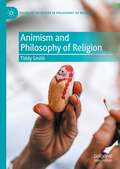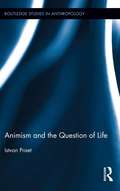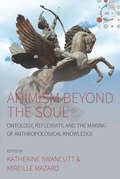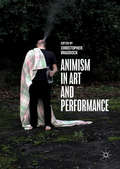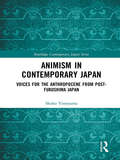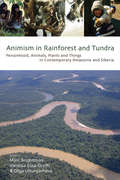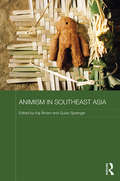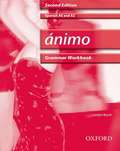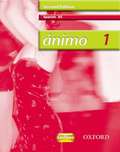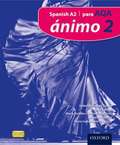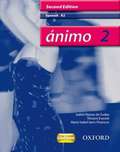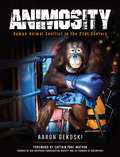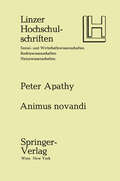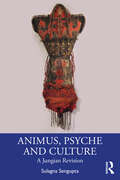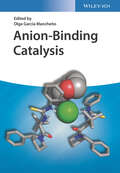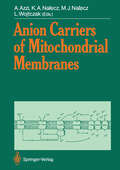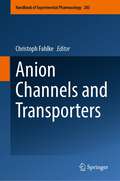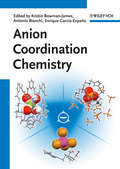- Table View
- List View
Animism and Philosophy of Religion (Palgrave Frontiers in Philosophy of Religion)
by Tiddy SmithMainstream philosophy of religion has persistently failed to engage seriously or critically with animist beliefs and practices. The field that is now called "philosophy of religion" could quite easily be renamed "philosophy of theism" with few lecturers on the subject having to change their lecture notes. It is the aim of this volume to rectify that failure and to present animism as a live option among the plethora of religious worldviews. The volume addresses four major questions: 1. What is this thing called "animism"? 2. Are there any arguments for or against animist belief and practice? 3. What is the relationship between animism, naturalism, and the sciences? And 4. Should we take animism seriously? Animism and Philosophy of Religion is intended to be the first authoritative scholarly volume on the issue of animism and its place in the philosophy of religion. Ambitiously, it aims to act as the cornerstone volume for future work on the subject and as a key text for courses engaging with the subject.
Animism and the Question of Life (Routledge Studies in Anthropology)
by Istvan PraetThe central purpose of this book is to help change the terms of the debate on animism, a classic theme in anthropology. It combines some of the finest ethnographic material currently available (including firsthand research on the Chachi of Ecuador) with an unusually broad geographic scope (the Americas, Asia, and Africa). Edward B. Tylor originally defined animism as the first phase in the development of religion. The heyday of cultural evolutionism may be over, but his basic conception is commonly assumed to remain valid in at least one respect: there is still a broad consensus that everything is alive within animism, or at least that more things are alive than a modern scientific observer would allow for (e.g., clouds, rivers, mountains) It is considered self-evident that animism is based on a kind of exaggeration: its adherents are presumed to impute life to this, that and the other in a remarkably generous manner. Against the prevailing consensus, this book argues that if animism has one outstanding feature, it is its peculiar restrictiveness. Animistic notions of life are astonishingly uniform across the globe, insofar as they are restricted rather than exaggerated. In the modern Western cosmology, life overlaps with the animate. Within animism, however, life is always conditional, and therefore tends to be limited to one’s kin, one’s pets and perhaps the plants in one’s garden. Thus it emerges that "our" modern biological concept of life is stranger than generally thought.
Animism and the Question of Life: Animism And The Question Of Life (Routledge Studies in Anthropology)
by Istvan PraetThe central purpose of this book is to help change the terms of the debate on animism, a classic theme in anthropology. It combines some of the finest ethnographic material currently available (including firsthand research on the Chachi of Ecuador) with an unusually broad geographic scope (the Americas, Asia, and Africa). Edward B. Tylor originally defined animism as the first phase in the development of religion. The heyday of cultural evolutionism may be over, but his basic conception is commonly assumed to remain valid in at least one respect: there is still a broad consensus that everything is alive within animism, or at least that more things are alive than a modern scientific observer would allow for (e.g., clouds, rivers, mountains) It is considered self-evident that animism is based on a kind of exaggeration: its adherents are presumed to impute life to this, that and the other in a remarkably generous manner. Against the prevailing consensus, this book argues that if animism has one outstanding feature, it is its peculiar restrictiveness. Animistic notions of life are astonishingly uniform across the globe, insofar as they are restricted rather than exaggerated. In the modern Western cosmology, life overlaps with the animate. Within animism, however, life is always conditional, and therefore tends to be limited to one’s kin, one’s pets and perhaps the plants in one’s garden. Thus it emerges that "our" modern biological concept of life is stranger than generally thought.
Animism beyond the Soul: Ontology, Reflexivity, and the Making of Anthropological Knowledge (Studies in Social Analysis #6)
by Katherine Swancutt and Mireille MazardHow might we envision animism through the lens of the ‘anthropology of anthropology’? The contributors to this volume offer compelling case studies that demonstrate how indigenous animistic practices, concepts, traditions, and ontologies are co-authored in highly reflexive ways by anthropologists and their interlocutors. They explore how native epistemologies, which inform anthropological notions during fieldwork, underpin the dialogues between researchers and their participants. In doing so, the contributors reveal ways in which indigenous thinkers might be influenced by anthropological concepts of the soul and, equally, how they might subtly or dramatically then transform those same concepts within anthropological theory.
Animism in Art and Performance
by Christopher BraddockThis book explores Māori indigenous and non-indigenous scholarship corresponding with the term ‘animism’. In addressing visual, media and performance art, it explores the dualisms of people and things, as well as 'who' or 'what' is credited with 'animacy'. It comprises a diverse array of essays divided into four sections: Indigenous Animacies, Atmospheric Animations, Animacy Hierarchies and Sensational Animisms. Cassandra Barnett discusses artists Terri Te Tau and Bridget Reweti and how personhood and hau (life breath) traverse art-taonga. Artist Natalie Robertson addresses kōrero (talk) with ancestors through photography. Janine Randerson and sound artist Rachel Shearer consider the sun as animate with mauri (life force), while Anna Gibb explores life in the algorithm. Rebecca Schneider and Amelia Jones discuss animacy in queered and raced formations. Stephen Zepke explores Deleuze and Guattari's animist hylozoism and Amelia Barikin examines a mineral ontology of art. This book will appeal to readers interested in indigenous and non-indigenous entanglements and those who seek different approaches to new materialism, the post-human and the anthropocene.
Animism in Art and Performance
by Christopher BraddockThis book explores Māori indigenous and non-indigenous scholarship corresponding with the term ‘animism’. In addressing visual, media and performance art, it explores the dualisms of people and things, as well as 'who' or 'what' is credited with 'animacy'. It comprises a diverse array of essays divided into four sections: Indigenous Animacies, Atmospheric Animations, Animacy Hierarchies and Sensational Animisms. Cassandra Barnett discusses artists Terri Te Tau and Bridget Reweti and how personhood and hau (life breath) traverse art-taonga. Artist Natalie Robertson addresses kōrero (talk) with ancestors through photography. Janine Randerson and sound artist Rachel Shearer consider the sun as animate with mauri (life force), while Anna Gibb explores life in the algorithm. Rebecca Schneider and Amelia Jones discuss animacy in queered and raced formations. Stephen Zepke explores Deleuze and Guattari's animist hylozoism and Amelia Barikin examines a mineral ontology of art. This book will appeal to readers interested in indigenous and non-indigenous entanglements and those who seek different approaches to new materialism, the post-human and the anthropocene.
Animism in Contemporary Japan: Voices for the Anthropocene from post-Fukushima Japan (Routledge Contemporary Japan Series)
by Shoko Yoneyama‘Postmodern animism’ first emerged in grassroots Japan in the aftermath of mercury poisoning in Minamata and the nuclear meltdown in Fukushima. Fusing critiques of modernity with intangible cultural heritages, it represents a philosophy of the life-world, where nature is a manifestation of a dynamic life force where all life is interconnected. This new animism, it is argued, could inspire a fundamental rethink of the human-nature relationship. The book explores this notion of animism through the lens of four prominent figures in Japan: animation film director Miyazaki Hayao, sociologist Tsurumi Kazuko, writer Ishimure Michiko, and Minamata fisherman-philosopher Ogata Masato. Taking a biographical approach, it illustrates how these individuals moved towards the conclusion that animism can help humanity survive modernity. It contributes to the Anthropocene discourse from a transcultural and transdisciplinary perspective, thus addressing themes of nature and spirituality, whilst also engaging with arguments from mainstream social sciences. Presenting a new perspective for a post-anthropocentric paradigm, Animism in Contemporary Japan will be useful to students and scholars of sociology, anthropology, philosophy and Japanese Studies.
Animism in Contemporary Japan: Voices for the Anthropocene from post-Fukushima Japan (Routledge Contemporary Japan Series)
by Shoko Yoneyama‘Postmodern animism’ first emerged in grassroots Japan in the aftermath of mercury poisoning in Minamata and the nuclear meltdown in Fukushima. Fusing critiques of modernity with intangible cultural heritages, it represents a philosophy of the life-world, where nature is a manifestation of a dynamic life force where all life is interconnected. This new animism, it is argued, could inspire a fundamental rethink of the human-nature relationship. The book explores this notion of animism through the lens of four prominent figures in Japan: animation film director Miyazaki Hayao, sociologist Tsurumi Kazuko, writer Ishimure Michiko, and Minamata fisherman-philosopher Ogata Masato. Taking a biographical approach, it illustrates how these individuals moved towards the conclusion that animism can help humanity survive modernity. It contributes to the Anthropocene discourse from a transcultural and transdisciplinary perspective, thus addressing themes of nature and spirituality, whilst also engaging with arguments from mainstream social sciences. Presenting a new perspective for a post-anthropocentric paradigm, Animism in Contemporary Japan will be useful to students and scholars of sociology, anthropology, philosophy and Japanese Studies.
Animism in Rainforest and Tundra: Personhood, Animals, Plants and Things in Contemporary Amazonia and Siberia
by UnknownAmazonia and Siberia, classic regions of shamanism, have long challenged ‘western’ understandings of man’s place in the world. By exploring the social relations between humans and non-human entities credited with human-like personhood (not only animals and plants, but also ‘things’ such as artifacts, trade items, or mineral resources) from a comparative perspective, this volume offers valuable insights into the constitutions of humanity and personhood characteristic of the two areas. The contributors conducted their ethnographic fieldwork among peoples undergoing transformative processes of their lived environments, such as the depletion of natural resources and migration to urban centers. They describe here fundamental relational modes that are being tested in the face of change, presenting groundbreaking research on personhood and agency in shamanic societies and contributing to our global understanding of social and cultural change and continuity.
Animism in Southeast Asia (Routledge Contemporary Southeast Asia Series)
by Guido Sprenger Kaj ÅrhemAnimism refers to ontologies or worldviews which assign agency and personhood to human and non-human beings alike. Recent years have seen a revival of this concept in anthropology, where it is now discussed as an alternative to modern-Western naturalistic notions of human-environment relations. Based on original fieldwork, this book presents a number of case studies of animism from insular and peninsular Southeast Asia and offers a comprehensive overview of the phenomenon – its diversity and underlying commonalities and its resilience in the face of powerful forces of change. Critically engaging with the current standard notion of animism, based on hunter-gatherer and horticulturalist societies in other regions, it examines the roles of life forces, souls and spirits in local cosmologies and indigenous religion. It proposes an expansion of the concept to societies featuring mixed farming, sacrifice and hierarchy and explores the question of how non-human agents are created through acts of attention and communication, touching upon the relationship between animist ontologies, world religion, and the state. Shedding new light on Southeast Asian religious ethnographic research, the book is a significant contribution to anthropological theory and the revitalization of the concept of animism in the humanities and social sciences.
Animism in Southeast Asia (Routledge Contemporary Southeast Asia Series)
by Guido Sprenger Kaj ÅrhemAnimism refers to ontologies or worldviews which assign agency and personhood to human and non-human beings alike. Recent years have seen a revival of this concept in anthropology, where it is now discussed as an alternative to modern-Western naturalistic notions of human-environment relations. Based on original fieldwork, this book presents a number of case studies of animism from insular and peninsular Southeast Asia and offers a comprehensive overview of the phenomenon – its diversity and underlying commonalities and its resilience in the face of powerful forces of change. Critically engaging with the current standard notion of animism, based on hunter-gatherer and horticulturalist societies in other regions, it examines the roles of life forces, souls and spirits in local cosmologies and indigenous religion. It proposes an expansion of the concept to societies featuring mixed farming, sacrifice and hierarchy and explores the question of how non-human agents are created through acts of attention and communication, touching upon the relationship between animist ontologies, world religion, and the state. Shedding new light on Southeast Asian religious ethnographic research, the book is a significant contribution to anthropological theory and the revitalization of the concept of animism in the humanities and social sciences.
Animo: Spanish AS and A2 (PDF)
by Carolyn Burch'Animo' provides a smooth transition from GCSE to A Level, with a diagnostic test to determine students' abilities, clear grammatical explanations and full practice and language learning strategies.
Animo 1: Student Book (2nd edition) (PDF)
by Vivancos, Maria Isabel Isern Vincent Everett Alonso de Sudea, Isabel'Animo' provides a smooth transition from GCSE to A Level, with a diagnostic test to determine students' abilities, clear grammatical explanations and full practice and language learning strategies.
Animo 2: Spanish A2 Para AQA (PDF)
by Vincent Everett Isern Vivancos, Maria Isabel Alonso De SudeaThese editions are a complete match to the AQA specification, giving you everything you need for AQA A Level Spanish. It offers comprehensive grammar and skills support, helping students understand and manipulate new language.
Animo 2 Spanish A2: Student Book (2nd edition) (PDF)
by Alonso de Sudea, Isabel'Animo' provides a smooth transition from GCSE to A Level, with a diagnostic test to determine students' abilities, clear grammatical explanations and full practice and language learning strategies.
Animosity: Human-Animal Conflict in the 21st Century
by Aaron GekoskiThe world’s wildlife is in crisis.Globally, animals are being traded, hunted, poached, consumed and exploited to the point of extinction. This is their story, as told through the lens and eyes of Aaron ‘Bertie' Gekoski, an internationally acclaimed environmental photojournalist, who documents human-animal conflict in the most inhospitable places on Earth.ANIMOSITY is a collection of powerful photographs and absorbing tales from the frontline of conservation: from Cambodia’s dog-drowning dungeons and West Africa’s voodoo markets, to cruel Wildlife Tourism Attractions and the shadowy world of the exotic pet trade.Conflict, conservation, and the battle to coexist: ANIMOSITY is the story of our generation, our legacy.Numerous animal welfare NGOs have lent their backing to the book including Born Free Foundation, Four Paws, World Animal Protection, International Animal Rescue, PETA & Scubazoo, while world famous actresses Shannon Elizabeth and Amy Jackson have written moving testimonies for the book.The foreword has been written by one of the best-known environmental activists in the world, Captain Paul Watson, founder of the Sea Shepherd conservation society and a co-founder of Greenpeace.
Animus novandi: Das Willensmoment beim römischen Schulderneuerungsvertrag (Linzer Hochschulschriften #9)
by Peter ApathyDie vorliegende Arbeit wurde von der Sozial-, Wirtschafts- und Rechtswissenschaftlichen Fakultät der Hochschule Linz im Winter semester 1974/75 als Habilitationsschrift angenommen. Ihr Erschei nen ermöglichte ein großzügiger Druckkostenbeitrag, für den ich dem Fonds zur Förderung der wissenschaftlichen Forschung in Oster reich Dank schulde. Herrn Professor Richard Holzhammer danke ich für die Aufnahme der Arbeit in die Linzer Hochschulschriften-Reihe. Mein besonderer Dank gilt meinen hochverehrten Lehrern, Frau Professor Marianne Meinhart und Herrn Professor Max Kaser. Frau Professor Marianne Meinhart hat mich für das Römische Recht in teressiert und meine Liebe zum wissenschaftlichen Arbeiten geweckt. Ihr unermüdliches Interesse und ihre stete Bereitschaft zur Diskus sion haben mich entscheidend gefördert. Die Anregung zur Unter suchung des animus novandi verdanke ich Herrn Professor Max Kaser, dessen ständige Anteilnahme und kritische Förderung mir wertvolle Hilfe war. Meinen Eltern darf ich dieses Buch in Dankbarkeit widmen. Linz, im Mai 1975 Peter Apathy 5 Inhaltsverzeichnis Erster Teil DAS PROBLEM DER HERKUNFT DES NOVATIONSWILLENS 13 § 1. Der Gegenstand der Untersuchung § 2. Der Stand der Meinungen 21 § 3. Die Terminologie 31 § 4. Die Methode . . . . . . . 40 Zweiter Teil DIE FUNKTION DES NOVATIONSWILLENS UND SEINE BEDEUTUNG 1. Kapitel Die Berufung auf den Parteiwillen zur Begründung des Nichteintritts der Novation § 5. Pomp. D. 46, 2, 7 41 § 6. Vip. D. 46, 2, 6 pr 66 § 7. VIp. D. 46, 2, 8, 3 . 72 § 8. VIp. D. 45, 2, 3 pr 76 2.
Animus, Psyche and Culture: A Jungian Revision
by Sulagna SenguptaAnimus, Psyche and Culture takes Carl Jung’s concept of contra-sexual psyche and locates it within the cultural expanse of India, using ethnographic narratives, history, religion, myth, films, biographical extracts to deliberate on the feminine in psychological, social and archetypal realms. Jung’s concept of unconscious contra-sexuality, based on notions of feminine Eros and masculine Logos, was pioneering in his time, but took masculine and feminine to be fixed and essential attributes of gender in the psyche. This book explores the relevance of the animus, examining its rationale in current contexts of gender fluidity. Taking off from Post Jungian critiques, it proposes an exposition of the animus in history, social and religious phenomena, theories of knowledge, psychoid archetype and synchronicity, to grasp its nuances in diverse cultural worlds. This study re-envisions the notion of animus keeping in mind the intricacies of feminine subjectivity and the diversity of cultural worlds where depth psychological ideas are currently emerging. A remarkable reworking of Jungian ideas, this well-researched and important new book will be an insightful read for Jungian analysts and scholars with an interest in cultural and gender studies.
Animus, Psyche and Culture: A Jungian Revision
by Sulagna SenguptaAnimus, Psyche and Culture takes Carl Jung’s concept of contra-sexual psyche and locates it within the cultural expanse of India, using ethnographic narratives, history, religion, myth, films, biographical extracts to deliberate on the feminine in psychological, social and archetypal realms. Jung’s concept of unconscious contra-sexuality, based on notions of feminine Eros and masculine Logos, was pioneering in his time, but took masculine and feminine to be fixed and essential attributes of gender in the psyche. This book explores the relevance of the animus, examining its rationale in current contexts of gender fluidity. Taking off from Post Jungian critiques, it proposes an exposition of the animus in history, social and religious phenomena, theories of knowledge, psychoid archetype and synchronicity, to grasp its nuances in diverse cultural worlds. This study re-envisions the notion of animus keeping in mind the intricacies of feminine subjectivity and the diversity of cultural worlds where depth psychological ideas are currently emerging. A remarkable reworking of Jungian ideas, this well-researched and important new book will be an insightful read for Jungian analysts and scholars with an interest in cultural and gender studies.
Anion-Binding Catalysis
by Olga Garcia-ManchenoExplores the potential of new types of anion-binding catalysts to solve challenging synthetic problems Anion-Binding Catalysis introduces readers to the use of anion-binding processes in catalytic chemical activation, exploring how this approach can contribute to the future design of novel synthetic transformations. Featuring contributions by world-renowned scientists in the field, this authoritative volume describes the structure, properties, and catalytic applications of anions as well as synthetic applications and practical analytical methods. In-depth chapters are organized by type of catalyst rather than reaction type, providing readers with an accessible overview of the existing classes of effective catalysts. The authors discuss the use of halogens as counteranions, the combination of (thio)urea and squaramide-based anion-binding with other types of organocatalysis, anion-binding catalysis by pnictogen and tetrel bonding, nucleophilic co-catalysis, anion-binding catalysis by pnictogen and tetrel bonding, and more. Helping readers appreciate and evaluate the potential of anion-binding catalysis, this timely book: Illustrates the historical development, activation mode, and importance of anion-binding in chemical catalysis Explains the analytic methods used to determine the anion-binding affinity of the catalysts Describes catalytic and synthetic applications of common NH- and OH-based hydrogen-donor catalysts as well as C-H triazole/triazolium catalysts Covers amino-catalysis involving enamine, dienamine, or iminium activation approaches Discusses new trends in the field of anion-binding catalysis, such as the combination of anion-binding with other types of catalysis Presenting the current state of the field as well as the synthetic potential of anion-binding catalysis in future, Anion-Binding Catalysis is essential reading for researchers in both academia and industry involved in organic synthesis, homogeneous catalysis, and pharmaceutical chemistry.
Anion-Binding Catalysis
by Olga García MancheñoExplores the potential of new types of anion-binding catalysts to solve challenging synthetic problems Anion-Binding Catalysis introduces readers to the use of anion-binding processes in catalytic chemical activation, exploring how this approach can contribute to the future design of novel synthetic transformations. Featuring contributions by world-renowned scientists in the field, this authoritative volume describes the structure, properties, and catalytic applications of anions as well as synthetic applications and practical analytical methods. In-depth chapters are organized by type of catalyst rather than reaction type, providing readers with an accessible overview of the existing classes of effective catalysts. The authors discuss the use of halogens as counteranions, the combination of (thio)urea and squaramide-based anion-binding with other types of organocatalysis, anion-binding catalysis by pnictogen and tetrel bonding, nucleophilic co-catalysis, anion-binding catalysis by pnictogen and tetrel bonding, and more. Helping readers appreciate and evaluate the potential of anion-binding catalysis, this timely book: Illustrates the historical development, activation mode, and importance of anion-binding in chemical catalysis Explains the analytic methods used to determine the anion-binding affinity of the catalysts Describes catalytic and synthetic applications of common NH- and OH-based hydrogen-donor catalysts as well as C-H triazole/triazolium catalysts Covers amino-catalysis involving enamine, dienamine, or iminium activation approaches Discusses new trends in the field of anion-binding catalysis, such as the combination of anion-binding with other types of catalysis Presenting the current state of the field as well as the synthetic potential of anion-binding catalysis in future, Anion-Binding Catalysis is essential reading for researchers in both academia and industry involved in organic synthesis, homogeneous catalysis, and pharmaceutical chemistry.
Anion Carriers of Mitochondrial Membranes
by Angelo Azzi Katarzyna A. Nalecz Maciej J. Nalecz Lech WojtczakIn order to provide a functional organisation of the various biochemical processes, the intracellular environment is subdivided into compartments formed by organelles. Mitochondria serve to restore energy-rich compounds, while energy is mainly consumed in the cytosolic space. Molecules involved in these metabolic cycles have to cross the mitochondrial membrane via specialized carriers embedded in the inner mitochondrial membrane. All relevant structural and functional aspects of the Anion Carriers of Mitochondrial Membranes as well as isolation procedures, reconstitution experiments and biogenesis of the carriers, kinetics of transport as well as the metabolic regulation mechanisms are treated in this volume.
Anion Channels and Transporters (Handbook of Experimental Pharmacology #283)
by Christoph FahlkeThis book provides an overview on recent progress in anion channels and transporters. It covers multiple scales of analysis ranging from studying the molecular basis of function at atomic resolution to cellular consequences to channel/transporter dysfunction and approaches to correct such processes by pharmacological intervention. Similar anion channels and transporters are expressed in multiple tissues – often fulfilling similar cellular tasks, but also clearly distinct functions. The aim is to combine work on multiple cell and organ systems.
Anion Coordination Chemistry
by Kristin Bowman-James Antonio Bianchi Enrique Garc 237 A-EspanaBuilding on the pioneering work in supramolecular chemistry from the last 20 years or so, this monograph addresses new and recent approaches to anion coordination chemistry. Synthesis of receptors, biological receptors and metallareceptors, the energetics of anion binding, molecular structures of anion complexes, sensing devices are presented and computational studies addressed to aid with the understanding of the different driving forces responsible for anion complexation. The reader is promised an actual picture of the state of the art for this exciting and constantly evolving field of supramolecular anion coordination chemistry. The topics range from ion channels to selective sensors, making it attractive to all researchers and PhD students with an interest in supramolecular chemistry.
Anion Coordination Chemistry
by Kristin Bowman-James Antonio Bianchi Enrique Garc 237 A-EspanaBuilding on the pioneering work in supramolecular chemistry from the last 20 years or so, this monograph addresses new and recent approaches to anion coordination chemistry. Synthesis of receptors, biological receptors and metallareceptors, the energetics of anion binding, molecular structures of anion complexes, sensing devices are presented and computational studies addressed to aid with the understanding of the different driving forces responsible for anion complexation. The reader is promised an actual picture of the state of the art for this exciting and constantly evolving field of supramolecular anion coordination chemistry. The topics range from ion channels to selective sensors, making it attractive to all researchers and PhD students with an interest in supramolecular chemistry.
